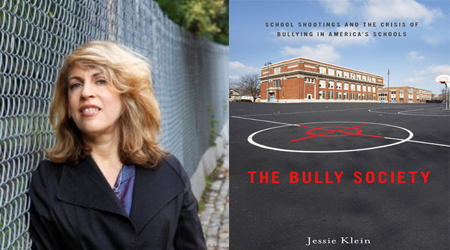
Why Have Cruelty and Violence Become a Normal Part of Our Children’s Education?
School Shootings and the Crisis of Bullying in America’s Schools
Twelve years after the Columbine High School massacre, school shootings have gone from a rare, shocking aberration to a frequent, yet still shocking, tragedy. Despite ubiquitous zero-tolerance policies, school violence continues. Even if they’re not getting beat up or shot at, students routinely endure verbal assaults and merciless torment from other students—often as teachers look the other way, or worse, join in. For many children and teens across the country, school feels like a hostile, oppressive, and dangerous place. www.jessieklein.com
Why has vicious bullying become commonplace in school? In THE BULLY SOCIETY: School Shootings and the Crisis of Bullying in America’s Schools (New York University Press; March 2012; $29.95 Cloth; ISBN: 0814748880), sociologist Jessie Klein delves into the roots of school violence in all its forms, from “everyday” bullying to shooting rampages to the alarming rise in adolescent depression and suicide. As Klein makes clear, bullying among young people is provoked by larger economic and cultural trends, reinforcing the values of high social status as well as values associated with masculinity—such as dominance and aggression. “To make schools safe,” Klein stresses, “we need to examine the pervasive forces that turn them into gender police training grounds.”
To get to the core of bullying, Klein draws on extensive studies and firsthand interviews with victims in schools from rural, inner-city, and wealthy suburban communities, along with her twenty-plus years of experience in education. Throughout, she shares the stories of men, women, and children who suffered—emotionally, psychologically, and physically—because of the norms of school culture.
Backed by hard-hitting statistics and haunting personal accounts, THE BULLY SOCIETY reveals:
• How students feel pressure to conform to rigid gender expectations and learn to practice gender policing, correcting their own and one another’s behaviors, attitudes, and dress according to their perceived expectations of what makes a boy “manly” and a girl feminine.
• How students get the message, from the media, as well as their parents and teachers, that status and power are everything—and then ridicule and attack boys who don’t fit the ideal or appear to be gay, geeky, nerdy, poor, or different.
• How boys learn from an early age to assert manhood by not only being popular with girls, but also by wielding power over them—physically, emotionally, and sexually— perpetuating sexual harassment and dating violence.
• How girls are increasingly pressured to be “tough,” to use violence as a means of proving themselves, as well as driven to conform to superficial and destructive standards of beauty, body type, and attractiveness to the opposite sex.
• How “gay-bashing,” “slut-bashing,” and other types of denigration of students by students are aggravated through text messages and in cyberspace, and
• How teachers often contribute to the bullying problem—and how adult role models, including parents, inadvertently or explicitly play out the same conflicts relating to wealth, race, looks, and sexuality, and bully not only one another, but also children.
What can concerned educators and parents do to stop this deeply hurtful yet widely accepted pattern of behavior? In THE BULLY SOCIETY, Klein calls for a radical transformation of the standard school culture. Going beyond inspiring ideas, she cites actual examples of school-based efforts, where teachers are working to bond with students and to help students reach across ethnic, economic, social, cultural, and gender divides to bond with one another. Rather than focusing on identifying a “troubled teen,” Klein shifts the goal to diagnosing disturbing values affecting the entire school and then committing to building a new culture of acceptance, where students of all kinds can become self-actualized and contributing people.
“I believe that change is possible in our schools,” Klein affirms. “Together we can move from a destructive one-size-fits-all bully society to more compassionate communities—where students, families, and community members can, instead, thrive.”


 Dr. Eddy Bayardelle Explains Global Classrooms
Dr. Eddy Bayardelle Explains Global Classrooms